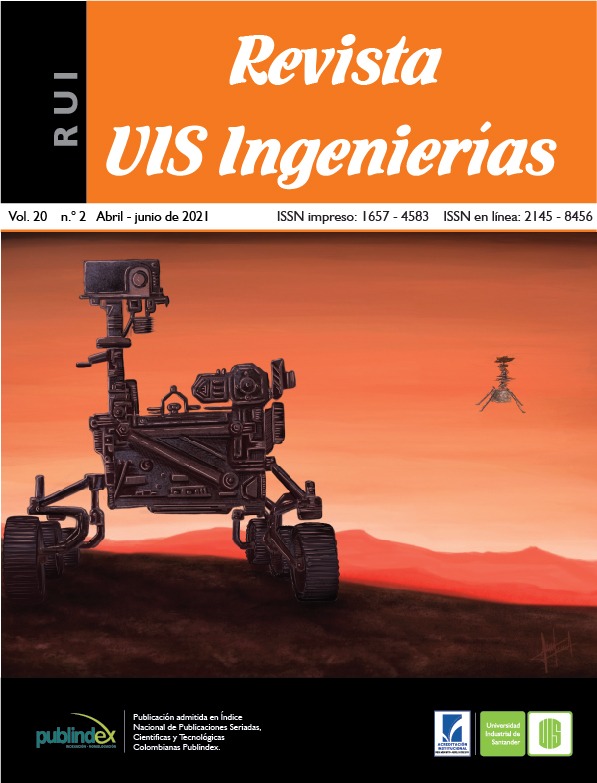Disturbances diagnostics methodology in the quality energy by means of S-Transform
Published 2021-02-17
Keywords
- electric power systems,
- local spectrum,
- power quality,
- S transform,
- time-frequency analysis
How to Cite
Abstract
This work shows a methodology known as the S Transform for time-frequency analysis of different distortions in electric power systems, which mostly are non-stationary and short-duration events, due to the contribution of network impedances and loads types connected by the users. The ability to identify all types of power quality distortions encrypted in the current and voltage signals is very important for failures and malfunctions analysis of monitoring equipment, protection, and control of electrical networks. An important feature of the S Transform is that it combines a frequency dependent resolution of time-frequency space, with information fully connected to the local phase. This allows defining the term of local phase spectrum. Additionally, it shows that amplitude response is invariant from frequency, in contrast to Wavelet and Short Time Fourier Transforms. The following study cases will be simulated by means of PSCAD software: motors starting up and shutting down, line-ground fault, zero-sequence harmonics in a balanced three-phase load, unbalanced three-phase load, a signal with high frequency components and notches presence.
Downloads
References
[2] W. R. Anis Ibrahim, M. M. Morcos, “Artificial intelligence and advanced mathematical tools for power quality applications: a survey”, en IEEE Transactions on Power Delivery, 2002, vol. 17, no. 2, pp. 668-673, doi: 10.1109/61.997958
[3] S. Elphick, P. Ciufo, G. Drury, V. Smith, S. Perera, V. Gosbell, “Large Scale Proactive Power-Quality Monitoring: An Example From Australia”, en IEEE Transactions on Power Delivery, 2017, vol. 32, no. 2, pp. 881-889, doi: 10.1109/TPWRD.2016.2562680
[4] Y. H. Gu, M. H. J. Bollen, “Time-frequency and time-scale domain analysis of voltage disturbances”, en IEEE Transactions on Power Delivery, 2000, vol. 15, no. 4, pp. 1279-1284, doi: 10.1109/61.891515
[5] D. Kumar, F. Zare, “Harmonic Analysis of Grid Connected Power Electronic Systems in Low Voltage Distribution Networks”, en IEEE Journal of Emerging and Selected Topics in Power Electronics, 2016, vol. 4, no. 1, pp. 70-79, doi: 10.1109/JESTPE.2015.2454537
[6] G. T. Heydt, P. S. Fjeld, C. C. Liu, D. Pierce, L. Tu, G. Hensley, “Applications of the windowed FFT to electric power quality assessment”, en IEEE Transactions on Power Delivery, 1999, vol. 14, no. 4, pp. 1411-1416, doi: 10.1109/61.796235
[7] P. A. Karafotis, P. S. Georgilakis, “Power quality monitoring and evaluation in power systems under non-stationary conditions using wavelet packet transform”, en High Voltage, 2019, vol. 4, no. 3, pp. 186-196, doi: 10.1049/hve.2019.0062
[8] T. Tarasiuk, Y. Zunino, M. Bueno-Lopez, F. Silvestro, A. Pilatis, M. Molinas, “Frequency Fluctuations in Marine Microgrids: Origins and Identification Tools”, en IEEE Electrification Magazine, 2020, vol. 8, no. 3, pp. 40-46, doi: 10.1109/MELE.2020.3005698
[9] D. S. Laila, A. R. Messina, B. C. Pal, “A Refined Hilbert–Huang Transform With Applications to Interarea Oscillation Monitoring”, en IEEE Transactions on Power Systems, 2009, vol. 24, no. 2, pp. 610-620, doi: 10.1109/TPWRS.2009.2016478
[10] O. Poisson, P. Rioual, M. Meunier, “Detection and measurement of power quality disturbances using wavelet transform”, en IEEE Transactions on Power Delivery, 2000, vol. 15, no. 3, pp. 1039-1044, doi: 10.1109/61.871372
[11] F. Zhao, R. Yang, “Power-Quality Disturbance Recognition Using S-Transform”, en IEEE Transactions on Power Delivery, 2007, vol. 22, no. 2, pp. 944-950, doi: 10.1109/TPWRD.2006.881575
[12] Li, Jianmin, et al. “Detection and classification of power quality disturbances using double resolution S-transform and DAG-SVMs”, en IEEE Transactions on Instrumentation and Measurement, 2016, vol. 65, no. 10, pp. 2302-2312, doi: 10.1109/TIM.2016.2578518
[13] Zhong, Tie, et al. “Power quality disturbance recognition based on multiresolution s-transform and decision tree”, en IEEE Access, 2019, vol. 7, pp. 88380-88392, doi: 10.1109/ACCESS.2019.2924918
[14] O. P. Mahela, A. Gafoor Shaik, “Recognition of power quality disturbances using S-transform based ruled decision tree and fuzzy C-means clustering classifiers”, Applied Soft Computing, 2017, vol. 59, pp. 243-257, doi: 10.1016/j.asoc.2017.05.061
[15] N. H. T. Huda, A. R. Abdullah, M. H. Jopri, “Power quality signals detection using S-transform”, en IEEE 7th International Power Engineering and Optimization Conference (PEOCO), 2013, pp. 552-557, doi: 10.1109/PEOCO.2013.6564609
[16] F. Zhao, R. Yang, “Power quality disturbance recognition using S-transform”, en IEEE Power Engineering Society General Meeting, 2006, doi: 10.1109/PES.2006.1709411
[17] P. K. Dash, B. K. Panigrahi, G. Panda, “Power quality analysis using S-transform”, en IEEE transactions on power delivery, 2003, vol. 18, no. 2, pp. 406-411, doi: 10.1109/TPWRD.2003.809616
[18] A. J. E. M. Janssen, “Optimality property of the Gaussian window spectrogram”, en IEEE Transactions on Signal Processing, 1991, vol. 39, no. 1, pp. 202-204, doi: 10.1109/78.80783
[19] R. Wilson, A. D. Calway, E. R. S. Pearson, “A generalized wavelet transform for Fourier analysis: the multiresolution Fourier transform and its application to image and audio signal analysis”, en IEEE Transactions on Information Theory, 1992, vol. 38, no. 2, pp. 674-690, doi: 10.1109/18.119730
[20] I. Daubechies, “The wavelet transform, time-frequency localization and signal analysis”, en IEEE Transactions on Information Theory,1990, vol. 36, no. 5, pp. 961-1005, doi: 10.1109 / 18.57199
[21] M. Varanini et al., “Spectral analysis of cardiovascular time series by the S-transform”, Computers in Cardiology, pp. 383-386, 1997, doi: 10.1109/CIC.1997.647913
[22] P. C. Chu, “The s-transform for obtaining localized spectral”, Journal of Marine Technological Society, vol. 29, no. 4, pp. 28-38, 1996.
[23] N. Liu, J. Gao, B. Zhang, F. Li, Q. Wang, “Time–Frequency Analysis of Seismic Data Using a Three Parameters S Transform”, en IEEE Geoscience and Remote Sensing Letters, 2018, vol. 15, no. 1, pp. 142-146, doi: 10.1109/LGRS.2017.2778045
[24] P. K. Dash, M. Nayak, M. R. Senapati, I.W.C. Lee, “Mining for similarities in time series data using wavelet-based feature vectors and neural networks”, Engineering Applications of Artificial Intelligence, vol. 20, no. 2, pp. 185-201, 2007, doi: 10.1016/j.engappai.2006.06.018


